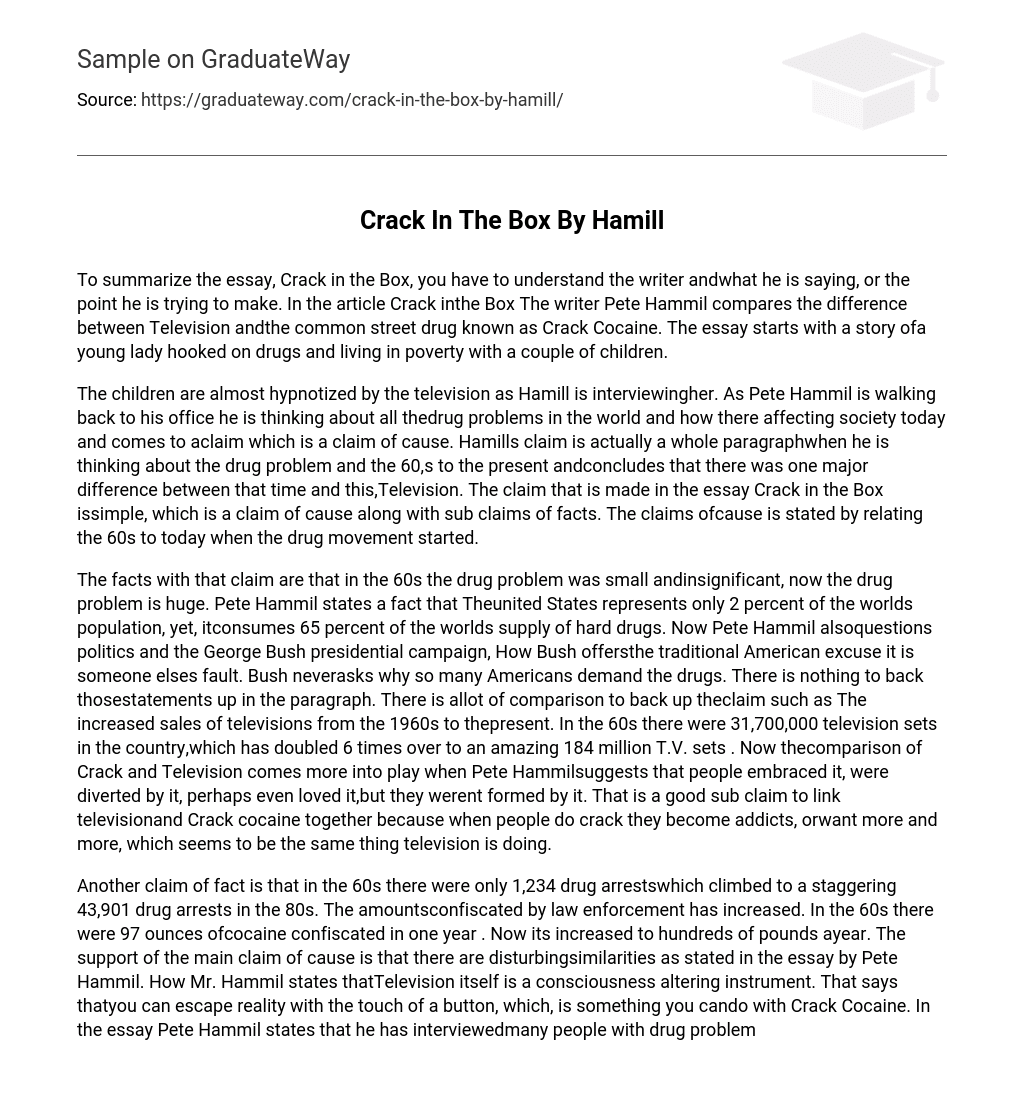To summarize the essay, Crack in the Box, you have to understand the writer andwhat he is saying, or the point he is trying to make. In the article Crack inthe Box The writer Pete Hammil compares the difference between Television andthe common street drug known as Crack Cocaine. The essay starts with a story ofa young lady hooked on drugs and living in poverty with a couple of children.
The children are almost hypnotized by the television as Hamill is interviewingher. As Pete Hammil is walking back to his office he is thinking about all thedrug problems in the world and how there affecting society today and comes to aclaim which is a claim of cause. Hamills claim is actually a whole paragraphwhen he is thinking about the drug problem and the 60,s to the present andconcludes that there was one major difference between that time and this,Television. The claim that is made in the essay Crack in the Box issimple, which is a claim of cause along with sub claims of facts. The claims ofcause is stated by relating the 60s to today when the drug movement started.
The facts with that claim are that in the 60s the drug problem was small andinsignificant, now the drug problem is huge. Pete Hammil states a fact that Theunited States represents only 2 percent of the worlds population, yet, itconsumes 65 percent of the worlds supply of hard drugs. Now Pete Hammil alsoquestions politics and the George Bush presidential campaign, How Bush offersthe traditional American excuse it is someone elses fault. Bush neverasks why so many Americans demand the drugs. There is nothing to back thosestatements up in the paragraph. There is allot of comparison to back up theclaim such as The increased sales of televisions from the 1960s to thepresent. In the 60s there were 31,700,000 television sets in the country,which has doubled 6 times over to an amazing 184 million T.V. sets . Now thecomparison of Crack and Television comes more into play when Pete Hammilsuggests that people embraced it, were diverted by it, perhaps even loved it,but they werent formed by it. That is a good sub claim to link televisionand Crack cocaine together because when people do crack they become addicts, orwant more and more, which seems to be the same thing television is doing.
Another claim of fact is that in the 60s there were only 1,234 drug arrestswhich climbed to a staggering 43,901 drug arrests in the 80s. The amountsconfiscated by law enforcement has increased. In the 60s there were 97 ounces ofcocaine confiscated in one year . Now its increased to hundreds of pounds ayear. The support of the main claim of cause is that there are disturbingsimilarities as stated in the essay by Pete Hammil. How Mr. Hammil states thatTelevision itself is a consciousness altering instrument. That says thatyou can escape reality with the touch of a button, which, is something you cando with Crack Cocaine. In the essay Pete Hammil states that he has interviewedmany people with drug problems and that none of them know why they do it theyjust give him a look like it makes me happy. The essay was veryinformative I thought, but I fail to see where the writer effectively sets forthethos, pathos, and logos. There was not enough evidence to back the story up tomake it believable. It was more of an opinion paper that might convince peoplethat are looking for something to believe about the drug problem and why itexists. Although there is a connection between the two. Television is an escapefrom reality as are drugs. But I dont think that they can be linked to eachother because they are 2 different worlds. The facts that are statedthroughout the essay are a good way to apply ethos, pathos, and logos, although, they are not convincing enough to make a believer out of everyone who readsthe paper. Hamills claim is inferred in my opinion, it is in the middle ofthe paragraph and it is Hamill thinking and he then comes to a conclusion thatseems to be the claim. Now ethos is applied when Hamill is telling the story inthe beginning about the woman on drugs. The story supports Ethos and makes itemotionally appealing for the reader, so the reader will be interested rightaway. The warrants are stated as facts throughout the essay, by stating factswhen analyzing TV and drugs. The end of the story also has a sub claim ofpolicy, by asking the question what can be done referring to the drugproblem and TV addiction. The sub claim of policy is backed up by suggestingways to better peoples understanding on TV and its effects ,the drugproblem , and taking action on the issues that Hamill presents. The end ofthe story has a sub claim of policy as stated earlier. Which is a stated claimwhen Hamill states for years the defenders of television have argued that thenetworks are only giving people what they want. That might be true. But so isthe Medellin Cartel.
BibliographyHamill, Pete Crack in the Box in Perspectives in Argument. Nancy. V.Wood. 2nd edition. Upper Saddle River, NJ : Prentice Hall , 1998. pg. 599-603English Essays





